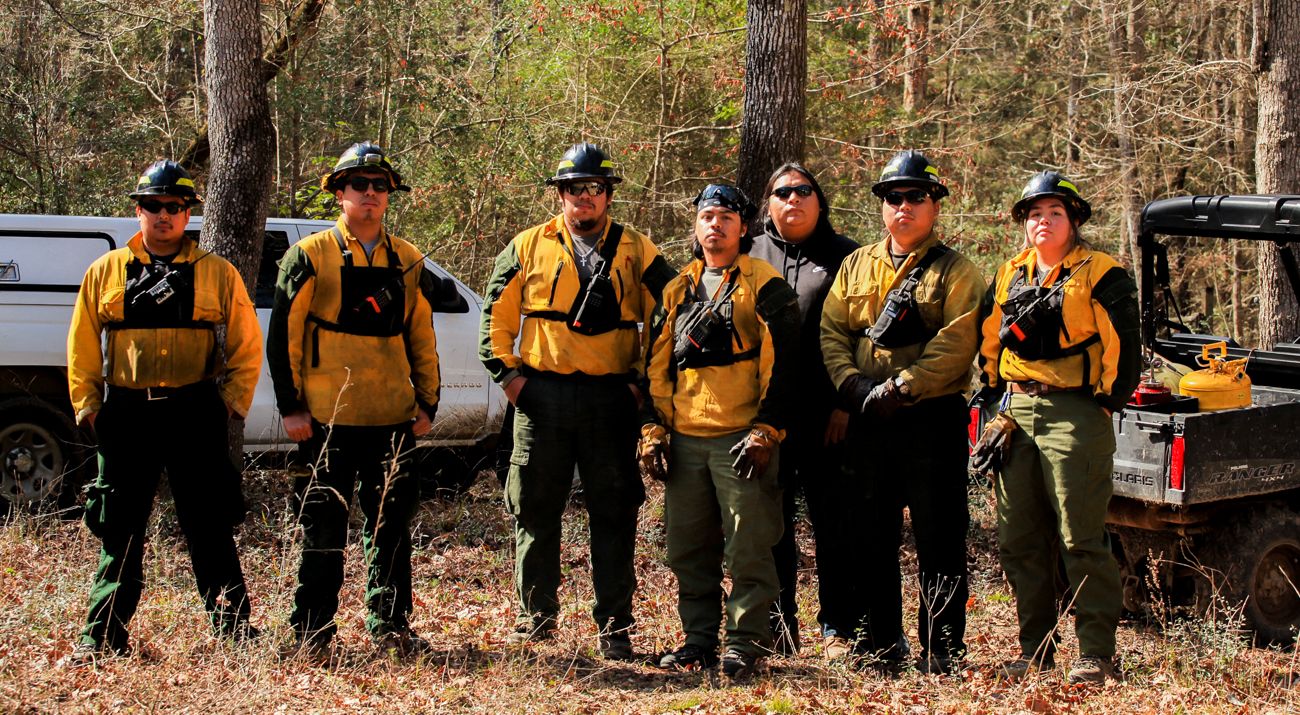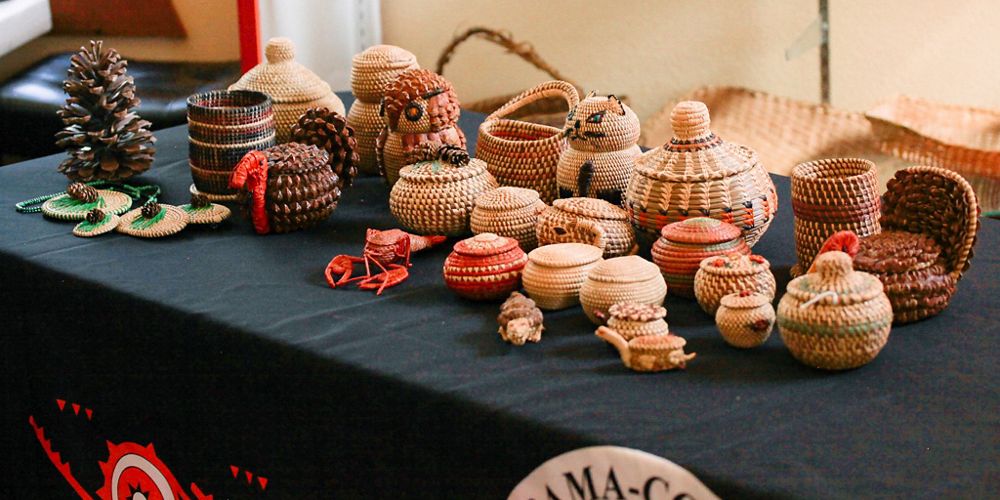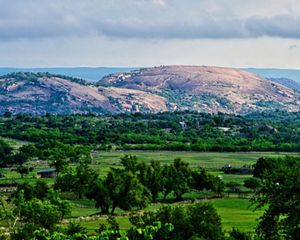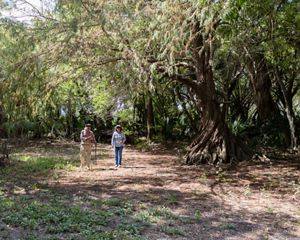Ensuring a Legacy of Longleaf
An in-depth look at the longleaf pine and its interwoven relationship to the Alabama-Coushatta Tribe of Texas.
The Tree that Fire Built
Long Live the Longleaf
The existence of the Alabama-Coushatta Tribe of Texas is one richly tied to that of the longleaf pine. From building homes and weaving baskets to serving important medicinal purposes, the longleaf has stood as a pillar of the Alabama-Coushatta’s way of life, shaping their culture and customs—but the loss of over 95% of longleaf forests means that these traditions and practices, passed down over centuries, also risk being lost to time. Without healthy, resilient stands of longleaf, both the Alabama-Coushatta and the Big Thicket are in danger of losing one of their most critical, defining elements.
The Alabama-Coushatta are stewards of their lands, using effective land management practices to enhance nature for their community. This good management includes reversing nearly 100 years of fire suppression. While Indigenous peoples have used controlled burns for millennia to manage their lands in North America, recent policies focused on suppressing fire, along with the forced removal of tribes from their native lands, have detrimentally impacted both people and nature. This includes the longleaf pine, which is fire-dependent and relies on regular intervals of fire to thrive.
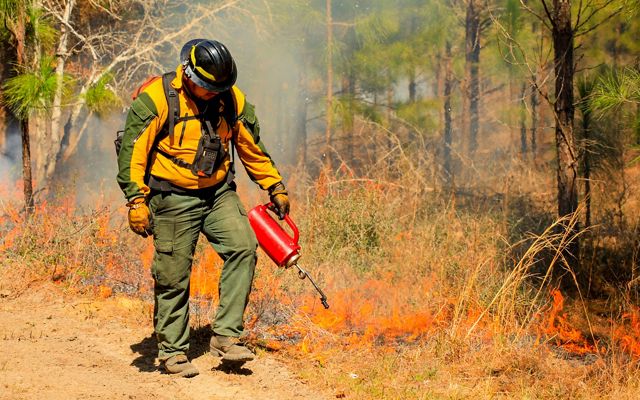

As a result, prescribed fire is playing a key part in restoration efforts to help keep the longleaf's legacy alive and flourishing. The Alabama-Coushatta Tribe has taken a proactive approach in actively managing longleaf pine trees, investing in facilities, personnel and equipment. When the Alabama-Coushatta and The Nature Conservancy in Texas recognized that each was working toward the same goal of restoring the longleaf, a unique partnership was formed. With the support of the Indigenous Peoples Burning Network, TNC was able to participate in funding the Alabama-Coushatta’s Wildland Fire Management crew with gear, equipment and training.
In addition, the Bureau of Indian Affairs (BIA) Southern Plains Region extended Hazardous Fuels Reduction (HFR) investment and established a Reserved Treaty Rights Lands (RTRL) program that expanded the tribe’s capacity to implement longleaf restoration both on tribal and collaborator lands. As partners in prescribed fire, the sharing of resources and personnel between the Alabama-Coushatta and TNC is helping elevate restoration efforts, so that longleaf can long live throughout Southeast Texas.
Flames for the Longleaf
The longleaf pine was built by fire. Long before suppression became the norm, fires once naturally occurred every two to 10 years, ensuring the longleaf received the flames it was made to withstand. Today, there's no question that bringing back the longleaf means bringing back fire.
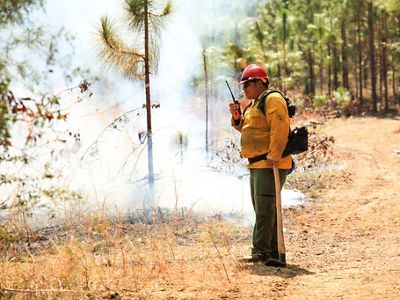
Traditionally, the Alabama-Coushatta Tribe of Texas used controlled burns not only to manage their lands but also to maintain trade routes and even hunt. In 2012, the tribe planted over 200 acres of longleaf seedlings. Now mostly mature, these longleafs are stewarded with prescribed fire by the tribe's Wildland Fire Management crew.
Headed by Gesse Bullock, the Wildland Fire Management team is working hard to remove competing vegetation, create healthier stands through thinning, and put nutrients back into the soil. Ultimately, the Alabama-Coushatta Tribe of Texas hopes to restore and preserve nearly 400 acres of longleaf pine forest on tribal lands with prescribed fire playing a leading role in this endeavor.
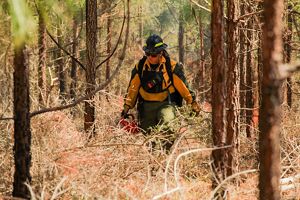

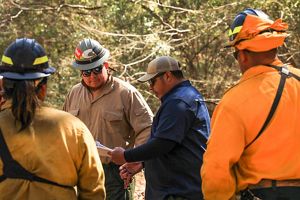
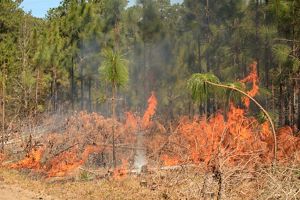
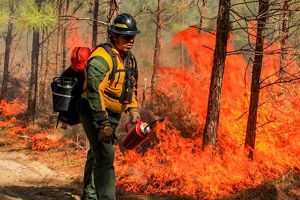
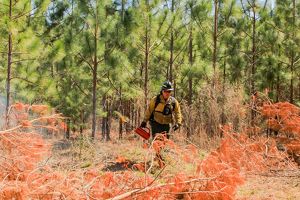
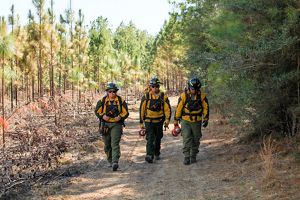
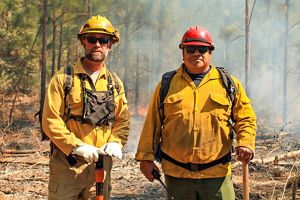

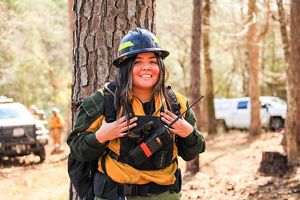

RESTORATION IN ACTION: Charity Battise of the Alabama-Coushatta Tribe of Texas ignites encroaching brush and competing vegetation, creating healthier conditions for the longleafs to grow. © Claire Everett/TNC

LONGLEAF GROWTH: Longleaf needles, which come in bundles of three, can grow up to 18 inches long. © Claire Everett/TNC

BEFORE FLAMES: Gesse Bullock gathers the tribe's Wildland Fire Management crew for a briefing before a prescribed burn on roughly 50 acres of longleaf pine forest. © Claire Everett/TNC

FIRE RESISTANT: Longleaf pines protect their bud from flames using their long needles, and thick bark insulates their trunks. Once mature, needle litter promotes fire across the forest floor. © Claire Everett/TNC

FANNING THE FLAMES: The prescribed fire briefly becomes more intense as flames compete for available oxygen and fuel. © Claire Everett/TNC

A BURN PLAN: A member of the tribe's Wildland Fire Management crew emerges after making a pass through the forest with a drip torch. Crew members take turns making passes across the area. © Claire Everett/TNC

AFTER THE BURN: Once the active burn is over, Wildland Fire Management crew members monitor the remaining flames and ensure the prescribed fire is extinguished. © Claire Everett/TNC

PARTNERS IN FIRE: TNC is helping to provide training, equipment and gear to the Tribe's Wildland Fire Management crew as part of our partnership. © Claire Everett/TNC

FIRE FOR GROWTH: Without regular occurences of fire, non-native plants can overgrow and outcompete longleaf seedlings. © Claire Everett/TNC

FIRE FOR THE FUTURE: TNC Texas staff and others established a partnership with the Alabama-Coushatta Tribe of Texas to implement longleaf restoration both on tribal and collaborator lands. © Claire Everett/TNC
Finding the Perfect Needle
Needle harvesting is the first step in traditional basket weaving. Harvesters thoughtfully select fully grown needles, free of blemishes or signs of insects. As needles are gathered, it's important that the collector does so with a happy and clear state of mind. Like all aspects of basket weaving, what you feel is woven into the basket, taking on one's emotions and energy.
Once chosen, the needle clusters are carefully pulled from their branches, or fascicles, ensuring that the longleaf isn't hurt or impacted by the harvesting. The needles are then dried for at least a month, depending on the color the weaver seeks to incorporate in their basket design.
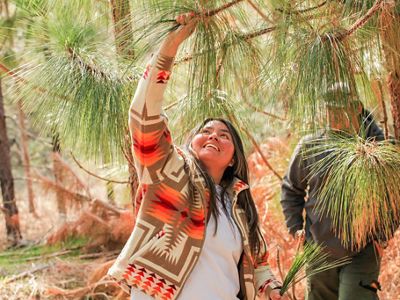
Before restoration efforts began, traditional basket weavers of the Alabama-Coushatta Tribe of Texas had to travel to Louisiana to harvest needles. But now, mature longleaf stands on tribal lands are ensuring this resource is more readily available.
Weaving New Life into the Longleaf
Intricate and detailed, the art of basket weaving is one being passed down from Elders to generations of tribal citizens. With each new weaver, this tradition lives on, giving life to the longleaf in an exceptional way while preserving a piece of the Alabama-Coushatta's history.
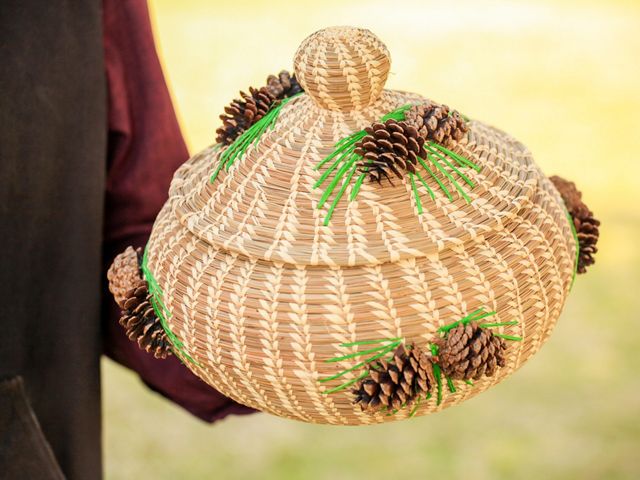
Basket-making is a detailed process that takes patience and creative vision. Once dried, weavers bundle the longleaf needles and coil them into baskets using raffia and sewing needles. Finished baskets are often decorated with pinecones, vibrant raffia flowers, or geometric patterns. Some advanced weavers have even crafted elaborate baskets in the shape of local wildlife and other animals.
Like harvesting, weaving requires a positive state of mind. Intertwining adverse thoughts into a basket as it's woven and filling it with negative energy are considered bad practices. In fact, as a weaver works on a new creation, sometimes the best thing to do is simply set the basket down until they can return to it with contentment and pride.
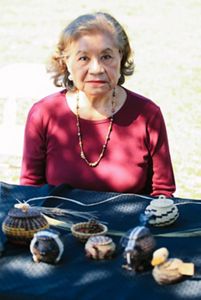
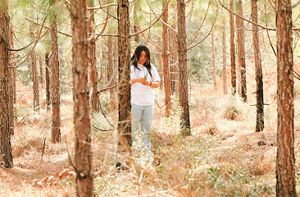
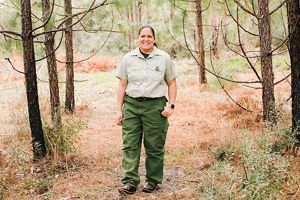
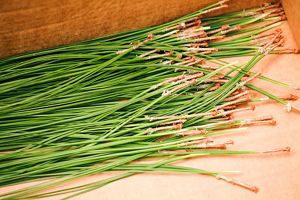
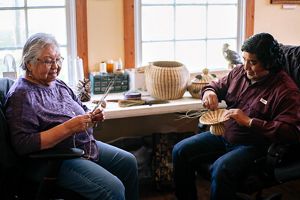
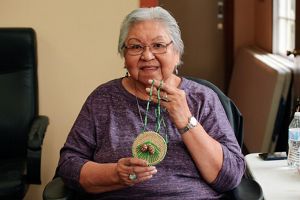
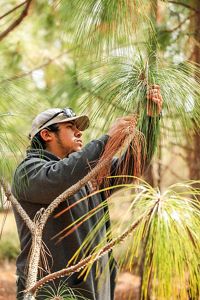
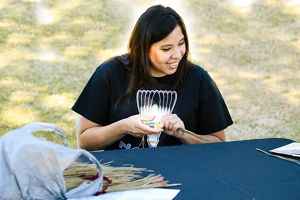
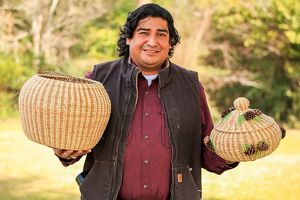
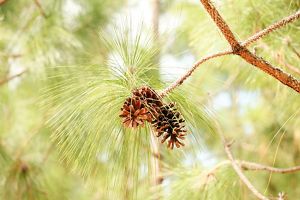

THE ART OF WEAVING: Gladys Shutt, an expert weaver of the Alabama-Coushatta Tribe of Texas, displays the traditional and animal-shaped baskets she's made from longleaf pine needles. © Claire Everett/TNC

SELECTING PINE NEEDLES: Charity Battise of the Alabama-Coushatta Tribe of Texas harvests longleaf pine needles for basket weavers. © Claire Everett/TNC

HELPING WITH THE HARVEST: Krista "KK" Langley, a tribal citizen and USDA Forest Service employee, monitors the harvest. © Claire Everett/TNC

A SUCCESSFUL HARVEST: Once collected, needles must dry for at least one month. Over this time, they lose their bright green coloring, turning brown. © Claire Everett/TNC

A CREATIVE CUSTOM: Joyce regularly teaches basket weaving classes to tribal citizens of all ages. Elliott credits her as his teacher, mentor and best critic in learning basketry. © Claire Everett/TNC

BEYOND BASKETS: Longleaf pine needles are also used to weave elegant pendant necklaces, like this one woven by Joyce Poncho. © Claire Everett/TNC

CAREFUL SELECTION: Harvesters examine longleaf pine needles, selecting the best materials for weavers to craft their baskets. © Claire Everett/TNC

PASSED DOWN FOR GENERATIONS: Sequoia Obe sits with a bag of bundled needles as she begins to weave a new basket. It's essential that younger generations of tribal citizens learn this artistry to pass on. © Claire Everett/TNC

BEAUTIFUL BASKETRY: Elliott Abbey, a skilled weaver of the Coushatta Tribe of Louisiana, shows off a few of his longleaf baskets. © Claire Everett/TNC

NATURE'S ORNAMENTS: Pinecones from longleaf pines and other regional tree species, like loblolly pines, are often used to decorate baskets. © Claire Everett/TNC
We Can’t Save Nature Without You
Sign up to receive monthly conservation news and updates from Texas. Get a preview of Texas' Nature News email.

